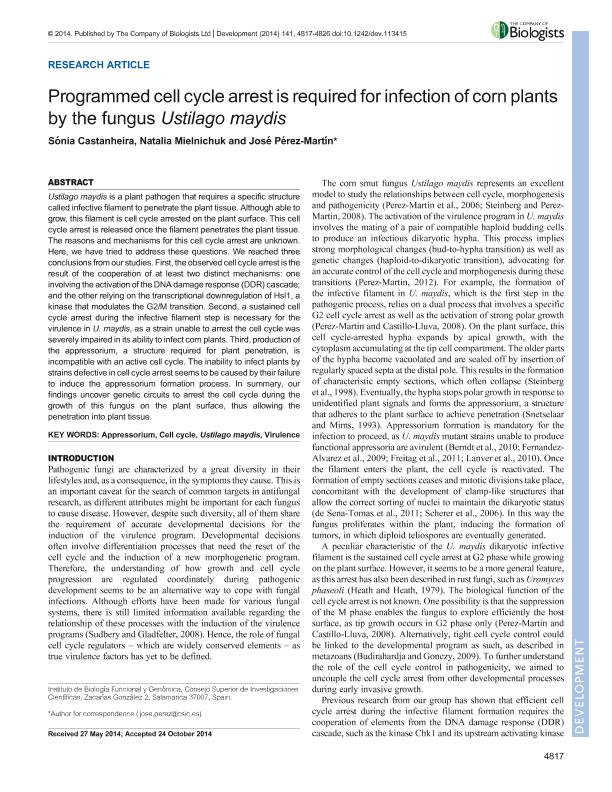Mostrar el registro sencillo del ítem
dc.contributor.author
Castanheira, Sónia
dc.contributor.author
Mielnichuk, Natalia

dc.contributor.author
Pérez Martín, José
dc.date.available
2016-02-05T12:38:41Z
dc.date.issued
2014-12
dc.identifier.citation
Castanheira, Sónia; Mielnichuk, Natalia; Pérez Martín, José; Programmed cell cycle arrest is required for infection of corn plants by the fungus Ustilago maydis; Company of Biologists; Development; 141; 24; 12-2014; 4817-4826
dc.identifier.issn
0950-1991
dc.identifier.uri
http://hdl.handle.net/11336/4044
dc.description.abstract
Ustilago maydis is a plant pathogen that requires a specific structure called infective filament to penetrate the plant tissue. Although able to grow, this filament is cell cycle arrested on the plant surface. This cell cycle arrest is released once the filament penetrates the plant tissue.<br />The reasons and mechanisms for this cell cycle arrest are unknown. Here, we have tried to address these questions. We reached three conclusions from our studies. First, the observed cell cycle arrest is the result of the cooperation of at least two distinct mechanisms: one involving the activation of the DNA damage response (DDR) cascade; and the other relying on the transcriptional downregulation of Hsl1, a kinase that modulates the G2/M transition. Second, a sustained cell cycle arrest during the infective filament step is necessary for the<br />virulence in U. maydis, as a strain unable to arrest the cell cycle was severely impaired in its ability to infect corn plants. Third, production of the appressorium, a structure required for plant penetration, is incompatible with an active cell cycle. The inability to infect plants by<br />strains defective in cell cycle arrest seems to be caused by their failure to induce the appressorium formation process. In summary, our findings uncover genetic circuits to arrest the cell cycle during the growth of this fungus on the plant surface, thus allowing the penetration into plant tissue.
dc.format
application/pdf
dc.language.iso
eng
dc.publisher
Company of Biologists

dc.rights
info:eu-repo/semantics/openAccess
dc.rights.uri
https://creativecommons.org/licenses/by-nc-sa/2.5/ar/
dc.subject
Appressorium
dc.subject
Cell Cycle
dc.subject
Ustilago Maydis
dc.subject
Virulence
dc.subject.classification
Biología Celular, Microbiología

dc.subject.classification
Ciencias Biológicas

dc.subject.classification
CIENCIAS NATURALES Y EXACTAS

dc.title
Programmed cell cycle arrest is required for infection of corn plants by the fungus Ustilago maydis
dc.type
info:eu-repo/semantics/article
dc.type
info:ar-repo/semantics/artículo
dc.type
info:eu-repo/semantics/publishedVersion
dc.date.updated
2016-03-30 10:35:44.97925-03
dc.journal.volume
141
dc.journal.number
24
dc.journal.pagination
4817-4826
dc.journal.pais
Reino Unido

dc.journal.ciudad
Cambridge
dc.description.fil
Fil: Castanheira, Sónia. Consejo Superior de Investigaciones Científicas. Instituto de Biología Funcional y Genómica; España
dc.description.fil
Fil: Mielnichuk, Natalia. Consejo Nacional de Investigaciones Científicas y Técnicas. Oficina de Coordinación Administrativa Parque Centenario. Instituto de Ciencias y Tecnología "Dr. Cesar Milstein"; Argentina. Consejo Superior de Investigaciones Científicas. Instituto de Biología Funcional y Genómica; España
dc.description.fil
Fil: Pérez Martín, José. Consejo Superior de Investigaciones Científicas. Instituto de Biología Funcional y Genómica; España
dc.journal.title
Development

dc.relation.alternativeid
info:eu-repo/semantics/altIdentifier/url/http://dev.biologists.org/content/141/24/4817.long
dc.relation.alternativeid
info:eu-repo/semantics/altIdentifier/doi/http://dx.doi.org/doi:10.1242/dev.113415
dc.relation.alternativeid
info:eu-repo/semantics/altIdentifier/issn/0950-1991
Archivos asociados
